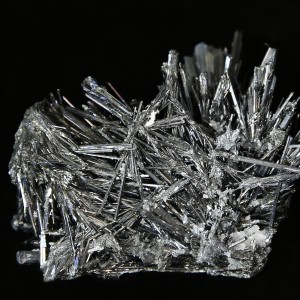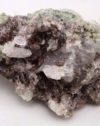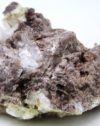HISTORY, NAME, LOCALITIES: Known since antiquity, stibnite received its name in 1854. The name “stibnite” pronounced STIBB-nite, is derived from stibi, the Greek name for the mineral. Stibnite is collected in Japan, China, Bolivia, Germany, Greece, Italy, Spain, and the United States (Alaska, California, Idaho).
MINERALOGY, PROPERTIES, OCCURRENCE: Stibnite [arsenic trisulfide, As2S3] crystallizes in the orthorhombic system as individual bladed or acicular prisms that often become intergrown to form jumbled, intricate aggregates. Stibnite is lead-gray in color and can exhibit a tarnish and iridescence. It has a bright metallic luster, a Mohs hardness of 2.0, perfect cleavage in one direction, and a specific gravity of 4.6. Stibnite occurs primarily in hydrothermal veins and hot-springs deposits in association with such minerals as cinnabar, realgar, and arsenopyrite.
METAPHYSICAL PROPERTIES, LORE, USES: Powdered stibnite has served as an eye-shadow material and pigment since ancient times. Modern metaphysical practitioners believe that stibnite enhances knowledge, guidance, and direction; facilitates understanding of the natural world; improves relationships; and increases the ability to understand one’s soul. Stibnite is the primary ore of the semimetal antimony. Antimony serves as an alloying metal and semiconductor; its compounds are used as flame retardants, pigments, and glass additives.
COLLECTORS’ INFORMATION: Stibnite makes especially desirable collectors’ specimens because of its bright, metallic luster and long, well-developed, striated crystals that often form jumbled, intricate aggregates.





 Axinite #10
Axinite #10  Axinite #8
Axinite #8